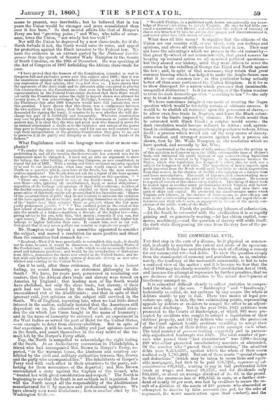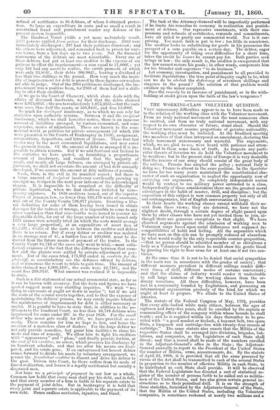THE COMMERCIAL EVIL.
THE first step in the cure of a disease, be it physical or commer- cial, is clearly to ascertain the extent and mode of its operation. Sir Richard Bethel has undertaken the task of effecting a remedy for our commercial rot—bad debts. To view the question simply from the stand-point of economy and punishment, as is, unfortu- nately, the tendency of the mercantile community, is but to take a confined view of the matter ; and it is because we fear that the Act of 1860 may too closely resemble the Consolidation Act of 1849, and increase the attempt at repression by further penalties, that we are desirous of drawing attention to the actual development of insolvency amongst us. It is somewhat difficult clearly to collect statistics to compre- hend the whole of the sore. " Bankruptcy " and "Insolvency," technically so called, do not embrace by any means the whole of debtors unable to pay in full. These two modes of legal pro- cedure are only, in fact, the two culminating points, representing appeals by debtors or creditors to compel the other to an adjust- ment and discharge. Yet in the year 1858, 1823 petitions were presented to the Courts of Bankruptcy, of which 897 were pre- sented by creditors who sought to compel a liquidation of their debtors' property, and 445 by debtors who sought the protection of the Court against hostile creditors unwilling to accept their share of the assets of their debtor pro rata amongst each other. The total number of persons trading separately and in partner- ship adjudicated bankrupts was 1320. The total number of per- sons who passed their "last examination" was 1280—leaving 240 who either presented unsatisfactory accounts or absconded. Of the number who "passed their examination," the admitted debts were 8,215,6291., against which the whole of their assets realized only 1,785,263/. But out of these assets "special charges and deductions" (which may be taken to mean liens and equit- able mortgages), had first to be paid 318,7291., expenses of ad- ministration 409,8521., leaving to pay in full preferential debts (such as wages and taxes) 28,2751., and for dividends only 933,6351., or about an average dividend of 2s. 6d. in the pound. So that the enormous loss of 409,8521. in costs, or a further divi- dend of nearly 50 per cent, was lost by creditors to secure the re- sult of a division of the assets of 240 persons who absconded or attempted to deceive by false accounts (we put, for the sake of argument, the worst construction upon their conduct), and the
refusal of certificates to 16 debtors, of whom 5 obtained protec- tion. So large an expenditure in costs and so small a result in ascertained fraud and punishment render any defence of the present system impossible.
The Insolvent Court yields a yet more melancholy result. 3337 persons applied from prison fur their discharge. 2483 were
immediatily discharged ; 287 had their petitions dismissed ; and the others were adjourned, and remanded back to prison for vari- ous terms, from a few days up to two years. But the financial statements of the debtors are most remarkable. Every one of these debtors had put at least one creditor to the expense of six guineas to effect the imprisonment—a sum equal to 21,000!.; yet only 181 had any assets to realize, the entire proceeds of which were only 33,864/., their debts 366,982/., leaving a dividend of less than two shillings in the pound. How very much the inuti- lity of imprisonment for debt is proved by these figures our readers are able to judge. Out of the 2984 petitioners discharged, the im- prisonment was a positive boon, for 2803 of them had not a shill- ing to offer their creditors.
If we go to the Court of Chancery, which alone deals with the affairs of deceased insolvents, we find that the debts claimed were 3,973,695/. ; the assets realized only 1,075,2631.—but the costs were more than half the assets, or 558,8441., and fees 15,990/.
So much for developed insolvency, as to which we can rely for statistics upon authentic returns. Between it and the incipient
insolvency, which we shall hereafter notice, there is an immense amount of liabilities arranged, by various economical, and some expensive, modes of adjustment. These are known to the com- mercial world as petitions for private arrangement (of which 240 were presented to the Courts of Bankruptcy in 1858), assignment, compositions, inspections, and letters of licence. These four last modes may be the most economical liquidations, and may cover the grossest frauds. Of the amount of debt so arranged it is im- possible to obtain returns. But if we add Scotland and Ireland to the statistics we have quoted, as furnishing a proportionate amount of insolvency, and recollect that the majority of small, and nearly all large failures, are arranged by private ad- justment, we shall not overstate the amount of bad debt annually developed, if we assume the amount at fifty millions of pounds.
Such,, then, is the evil in its manifest aspect ; but there is a large amount of incipient insolvency continually growing up amongst us, to ripen in the next year into one of the acknowledged shapes. It is impossible to be surprised at the difficulty of private liquidation, when we find creditors irritated by unne- cessary expenses. In 1858 creditors issued, out of the superior Courts of common law, no fewer than 103,478 writs of summons, and out of the County Courts 738,977 plaints. Granting a libe- ral deduction for some of them having been issued to obtain damages for the redress of wrongs, it is impossible to come to any other conclusion than that nine-tenths were issued to recover in- disputable debts, for out of the large number of writs issued only 1191 causes were actually tried (in which the costs would average a very large proportion), at an expenditure of court fees of 61,539!.; whilst of the costs as between the creditor and debtor there is no return. But if every debtor or creditor was mulcted in an average cost of 4/., a further loss of 400,000/. must be de- ducted from the future means of payment of the trader. In the County Court 84,719 of the cases only went to trial,—most satis- factory evidence of the fact that the difference between that num- ber and the plaints were settled by private adjustment or pay- ment. But of the cases tried, 175,952 ended in verdicts fir the plain tiff so unsatisfactory are the defences offered by debtors, and so numerous the resort to trials to gain time. The amount of debts claimed was 1,908,2191., the costs were 42,716/., and the court fees 219,911/. What amount was realized it is impossible to state.
Such is a fair statement of our actual commercial state, as far as it can be known with accuracy. But the facts and figures we have quoted suggest many very startling inquiries. We wish " no- thing to extenuate or aught set down in malice "; but if we add the costs of the several courts together, and to that the expense of maintaining the debtors' prisons, we may surely inquire whether the maintenance of imprisonment for debt is either necessary or useful. It is painful to have to state that, in addition to the pe- titioners to the Insolvent Court, no less than 10,748 debtors were imprisoned for sums under 20/. in the year 1858. For the small debtor who never gets credit for 204, we have provided no re- medy. There remains for him no hope in law, and hence the creation of a merciless class of dealers. For the large debtor we not only provide remedies, but grant him facilities to chose his mode and time of remedy, We allow him to fight his creditors with "appearances" and "pleas," and finally provide forhim, at the cost of his creditor, an arrest, which procures his discharge by an Insolvent schedule, and that too after his means are dissi- pated, and his estate gone. If an embarrassed but honest debtor comes forward to divide his assets by voluntary arrangement, we permit the fraudulent creditor to dissent and drive his debtor to the gaol. Driven into Court, he there suffers from its mode of forced realization, and leaves it a legally certificated but socially a disgraced man.
• Nor have we a principle of payment in our law as a whole. Common law holds that every man shall pay his debt, and in full, and that every member of a firm is liable in his separate estate to the payment of joint debts. But in bankruptcy it is held that every joint and separate estate is applicable to the payment of its own debt. Hence endless confusion, injustice, and fraud. The task of the Attorney-General will be imperfectly performed if he limits his remedies to economy in realization and punish- ment a debtors. Our repressive enactments, with their sus- pensions and refusals of certificates, remands and commitments, have all failed to purify our commercial world. Nor is it sur- prising. Too much faith is put in law ; too little in conscience. The creditor looks to substituting for goods in his possession the prospect of a sum payable on a certain day. The debtor, eager for the opportunity of tiding over difficulties for a short time, takes the credit he knows he cannot pay for. Both parties seek refuge in law : the only result is, the creditor is exasperated that the law cannot restore his goods ; in other words, compensate him for his blunder and eagerness "to do business." Let economy, investigation, and punishment be all provided to facilitate liquidations : the true point of inquiry ought to be, what can we do to abolish the deficiency of seventeen shillings 'and sixpence in the pound ? The solution of that problem would swallow up the minor complaint. Does the remedy lie in increase of punishment, or in the with- holding of credit given upon the faith of the law's vengeance ?



























 Previous page
Previous page